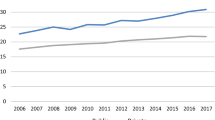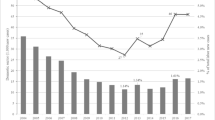Abstract
The present study aims to analyze the wage gap between the public and private sectors in Brazil from 2008 to 2016 based on microdata from the Annual Social Information Report (Relação Anual de Informações Sociais, RAIS). The results show that public-sector wages are higher than private-sector wages in Brazil and are decreasing at federal, state, and municipal levels. These differences are greater for workers in the judiciary, and in large municipalities and metropolises. The most skilled individuals receive lower salaries in the public sector, and the public–private difference is greater among women than men. It is also possible to verify that the wage gap can be explained better by the composition of employees in each sector than by the unobserved characteristics that affect the ways in which the sectors pay. At the end of the analyzed period, there is a reduction in participation in private-sector employment and an increase in the public–private wage gap with the economic downturn in the country.

Source: Authors based on RAIS-MTE microdata

Source: Own elaboration based on the results of the estimates

Source: Authors based on RAIS-MTE microdata
Similar content being viewed by others
Notes
The Brazilian Constitution of 1988, through article 41 of amendment 19, guarantees the right to stability for public servants who have completed 3 years of effective service.
In 2009, there are 59,266,468, in 2010 64,710,125, in 2011 68,685,012, in 2012 70,855,297, in 2013 72,795,943, in 2014 73,371,176, and in 2015, 69,312,349 observations.
It is important to mention that, for variable real wage–time construction, wages were corrected by the Índice Nacional de Preços ao Consumidor Amplo (IPCA) based on December 2016.
This classification was designed according to the Brazilian Institute of Geography and Statistics (IBGE 2017), which defines small size 1 municipalities with up to 20,000 inhabitants, small size 2 municipalities from 20,001 to 50,000, medium-sized population from 50,001 to 100,000, large size from 100,001 to 900,000, and metropolises with more than 900,000 inhabitants.
The “other” category refers to workers for whom there is no definition of sphere, for example, public companies or cooperatives. It was thus decided to create this fourth denomination.
The literature has discussed the problem of choosing the nondiscriminatory coefficient vector, called by Oaxaca (1973) the index number problem. Besides the approach used here, there are other suggestions, such as the average coefficients of the two groups (Cotton 1988) and that obtained from a joint regression (Neumark 1988).
References
Barbosa, A.L.N.deH., and F.H. Barbosa Filho. 2012. Diferencial de salários entre os setores públicos e privado no Brasil: um modelo de escolha endógena. Texto para discussão, n. 1713. Brasília: IPEA.
Bellante, D., and A.N. Link. 1981. Are public sector workers more risk averse than private sector workers? Industrial and Labor Relations Review 34(3): 408–412.
Bender, K.A. 1998. The central government-private sector wage differential. Journal of Economic Surveys 12(2): 177–220.
Bender, S., and R. Fernandes. 2006. Gastos públicos com pessoal: uma análise de emprego e salário no setor público brasileiro no período 1992–2004. In: Encontro Nacional de Economia, 34. Salvador: Anais… Salvador: ANPEC.
Blinder, A. 1973. Wage discrimination: reduced form and structural estimates. Journal of Human Resources 8(4): 433–455.
Braga, B.G. 2008. Educação, experiência e o hiato salarial entre o setor público e privado no Brasil. 48f. Dissertação (Mestrado em Economia Aplicada) – Departamento de Economia, Pontifícia Universidade Católica do Rio de Janeiro, Rio de Janeiro.
Brasil, R.G. 2016. Hiato de rendimentos público-privado: Decomposição quantílica inter-regional, 2004–2013. 90f. Dissertação (Mestrado em Desenvolvimento Econômico) – Setor de Ciências Sociais Aplicadas, Universidade Federal do Paraná, Curitiba. 2016.
Calixtre, A., and E. Fagnani. 2017. A política social e os limites do experimento desenvolvimentista (2003–2014). Texto para discussão, n. 295. Campinas: UNICAMP.
Campos, G.C.S. 2015. A evolução dos salários do emprego formal no Brasil (2003–2013). Revista da ABET (Online) 14(2): 220–240.
Cotton, J. 1988. On the decomposition of wage differentials. Review of Economics and Statistics 70: 236–243.
Cunha, M.S. 2008. Os empregados da agricultura brasileira: diferenciais e determinantes salariais. Revista de Economia e Sociologia Rural 46(3): 597–621.
Ehrenberg, R.G., and J.L. Schwarz. 1986. Public-sector labor markets. In Handbook of labor economics, vol. 2, ed. O.C. Ashenfelter and D. Card, 1219–1260. Amsterdam: North-Holland.
Foguel, W., and D. Lewin. 1974. Wage determination in the public sector. ILR Review 27(3): 410–431.
Gregory, R.G., and J. Borland. 1999. Recent developments in public sector labor markets. In Handbook of labor economics, vol. 3, ed. O.C. Ashenfelter and D. Card, 3573–3630. Amsterdam: North-Holland.
Hartog, J., and H. Oosterbeek. 1993. Public and private sector wages in the Netherlands. European Economic Review 37(1): 97–114.
Instituto Brasileiro De Geografia E Estatística. Disponível em: http://www.ibge.gov.br. Acesso em: 15 jul. 2017.
Leontaridi, M. 1998. Segmented labour markets: theory and evidence. Journal of Economic Surveys 12(1): 103–109.
Mattos, F.A.M. 2015. Avanços e dificuldades para o mercado de trabalho. Estudos Avançados 29(85): 69–85.
Nikolic, J., I. Rubil, and I. Tomic. 2017. Pre-crisis reforms, austerity measures and the public-private wage gap in two emerging economies. Economic Systems 41(2): 248–265.
Neumark, D. 1988. Employers discriminatory behavior and the estimation of wage discrimination. The Journal of Human Resources 23: 279–295.
Oaxaca, R. 1973. Male-female wage differentials in urban labor markets. International Economic Review 14(3): 693–709.
Organização para a Cooperação e Desenvolvimento Economico. 2013. Pensions at a glace 2013: OECD and G20 Indicators.
Palotti, P., and A. Freire. 2015. Perfil, composição e remuneração dos servidores públicos federais: trajetória recente e tendências observadas. In ENAP Servidores Públicos Federais: novos olhares e perspectivas, Orgs. P. Palotti, A. Freire. Brasília.
Secretaria do Tesouro Nacional. 2017a. Séries Temporais.
Secretaria do Tesouro Nacional. 2017b. Boletim das Finanças Públicas dos Entes Subnacionais.
Silva, E.deS., and R.M. Rocha. 2016. Diferenciais salariais entre os trabalhadores dos setores público e privado: heterogeneidade não observada e o viés de autosseleção setorial. In: Fórum Banco do Nordeste de Desenvolvimento, 22.; Encontro Regional de Economia, 21., 2016 Fortaleza. Anais…Fortaleza: ANPEC.
Smith, S.P. 1977. Government wage differentials. Journal of Urban Economics 4(3): 248–271.
Souen, J.A., and G.C.S. Campos. 2016. Da euforia ao retrocesso: o comportamento do emprego formal no Brasil no período recente. Revista da ABET 15(2): 87–106.
Souza, I.V., and A.F. Machado. 2004. Curva de rendimentos: uma análise no mercado de trabalho urbano e rural no Brasil (1981/99). Revista de Economia e Sociologia Rural 42(1): 35–54.
Tenoury, G.N., and N. Menezes-Filho. 2017. A Evolução do Diferencial Salarial Público-Privado no Brasil. Policy Paper. Centro de Políticas Públicas (INSPER), n. 29.
Vaz, D.V., and R. Hoffmann. 2007. Remuneração nos serviços no Brasil: o contraste entre funcionários públicos e privados. Revista Economia e Sociedade 16(2): 199–232.
World Bank. Size of the Public Sector: Government Wage Bill and Employment. 2016.
Acknowledgements
We thank the Brazilian agency CAPES (Coordenação de Aperfeiçoamento de Pessoal de Nível Superior) for financial support.
Author information
Authors and Affiliations
Corresponding author
Additional information
Publisher's Note
Springer Nature remains neutral with regard to jurisdictional claims in published maps and institutional affiliations.
Rights and permissions
About this article
Cite this article
Cardozo, D.P., da Cunha, M.S. Evidence of the Public–Private Wage Gap for Brazil in the Period from 2008 to 2016. Ind. J. Labour Econ. 62, 577–594 (2019). https://doi.org/10.1007/s41027-019-00190-9
Published:
Issue Date:
DOI: https://doi.org/10.1007/s41027-019-00190-9




